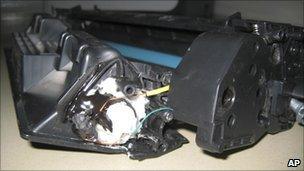Cargo bomb plot: What is the explosive PETN?
- Published

PETN was found inside the printer's toner cartridge
The explosive substance used in the air freight bomb plot was "cleverly" concealed inside a printer cartridge within a package, making it very difficult to detect. The bomb, containing PETN, was only discovered following a tip-off.
What is PETN and how much of a challenge does it present to air security?
The existence of PETN is nothing new. It is used widely in military and civilian life - such as for quarrying and demolitions - and is manufactured in many countries.
Although in this case it proved very difficult to detect, PETN itself is not necessarily hard to find using good swabbing and sniffer techniques, an expert told the BBC.
After two devices from Yemen, bound for the US, were intercepted by security officials in the UK and Dubai it transpired the PETN in the bombs had not been picked up by initial screening.
Crucially, this is down to the way it was disguised and not to the chemical itself, says explosives expert Roland Alford, managing director of Alford Technologies, which develops bomb disposal systems.
"PETN is one of the most common explosives. It does not surprise me that they did not detect it in this case. But chemically, it is easy to detect."
He said the substance, which is manufactured as a white powder and is often a component of plastic explosives like Semtex, is relatively sensitive. It is widely used by insurgent groups and was probably chosen for this plot because it is "very easy to set off".
Traces of the powerful substance - full name pentaerythritol tetranitrate - can be picked up on people, their bags or clothing via swabbing he says, adding that it had happened to him on past occasions.
"Because I handle PETN, when I travel I will have traces of it on my hand baggage, my keyboard and so on. At airport security if they do scan me I pull out my ID and start talking fast before they freak out.
"It can be detected on me weeks after I have been handling it. But they do have to take a swab and put it in the right place," he says.
He said the way it had been concealed in the printer's toner cartridge was "sophisticated" because it made swabbing for traces very difficult.
'Almost undetectable'
Likewise if sniffer dogs or machines are to find it, then the air from the container in which it is sealed needs to be "sucked out" first.
And while X-ray technology being developed will have the "intelligence" to detect explosive materials, the current technology used at airports cannot identify PETN, he added.
One of the key factors in this case appeared to be disguising the device so "it did not look like a bomb".
"In this case they used the fact that it was a powder in a compartment, within a device (a printer) in which you would expect to find powder."
He added: "It was a very clever way of disguising it."
Aviation security analyst Chris Yates also told the BBC that PETN could be "almost undetectable", even for sniffer dogs, if packed appropriately.
"There is a problem here. These people are getting very inventive in the way they package improvised explosive devices and they design those packages to evade the security procedures we have at our airports."
Moreover, getting hold of PETN - part of the same chemical family as nitroglycerin - is not necessarily difficult, adds Mr Alford.
A German security official has told the news agency AP that the bombs intercepted last week contained 300g and 400g of PETN.
Mr Alford said that although it was not "impossible" to create PETN it was not common to find it being home-made.
Viable bombs were "not particularly difficult" to make, said Mr Alford, but planning and executing such a plot was open to detection in many ways - whether through technology and security measures or, as in this case, intelligence.
"I think this time we were extremely lucky," he added.